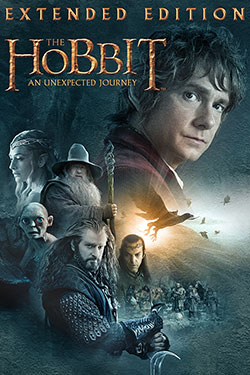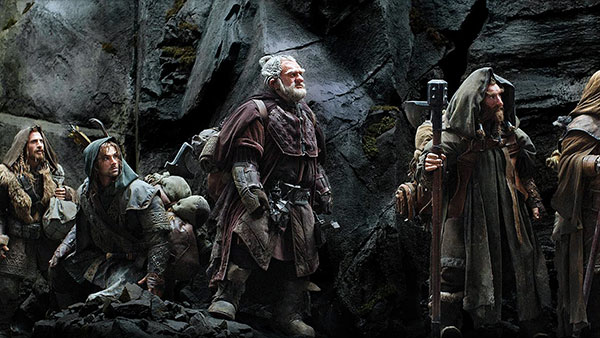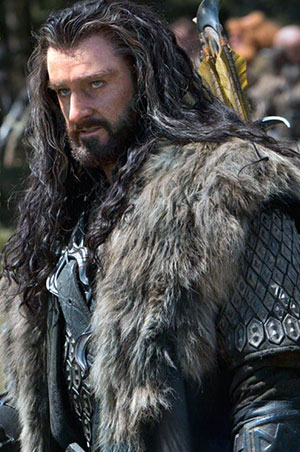Revisiting The Hobbit: An Unexpected Journey
by Ted Giese
 The Hobbit: The Desolation of Smaug is now in theatres but it’s worth taking a closer look at the first movie (An Unexpected Journey)—especially since the first film has just been released in an extended version with lots of great extras and behind-the-scenes insights.
The Hobbit: The Desolation of Smaug is now in theatres but it’s worth taking a closer look at the first movie (An Unexpected Journey)—especially since the first film has just been released in an extended version with lots of great extras and behind-the-scenes insights.
Many Christians as children read J.R.R Tolkien’s book The Hobbit and were enthralled by its adventure and characters: the Hobbit, Bilbo Baggins, pitiful Gollum, the Dwarf king-in-waiting Thorin Oakenshield and his twelve faithful companions, and the greedy dragon Smaug.
Part of what makes the book fascinating is how the author’s faith comes through even though he was not trying to write a “Christian” story. Since the films stick relatively close to the book, Christians will find certain things in The Hobbit films—or The Lord of the Rings films for that matter—have scriptural significance, things that resonate with the Christian faith. What makes it all a bit more complicated and fascinating, though, is that Tolkien wasn’t a fan of allegory. In fact, in a radio interview for the BBC radio program Now Read On…, Tolkien was asked by the host Dennis Gerrolt if his stories were “to be considered as an allegory.” Tolkien answered, “No. I dislike allegory whenever I smell it.”
In the same interview, however, Tolkien speaks of how some things can be ‘reminiscent’ of other things—not in a one-to-one parallel as in classic allegory, but in such a way that readers are reminded of other, deeper things. What Tolkien is talking about is more like symbolism than allegory, and it is apparent in books like The Hobbit.
In the Now Read On… interview we also find this interesting exchange. Gerrolt asks: “Did you intend in Lord of the Rings that certain races should embody certain principles: the Elves wisdom, the Dwarves craftsmanship, Men husbandry and battle, and so forth?”
Tolkien answers, “I didn’t intend it, but when you’ve got these people on your hands you’ve got to make them different, haven’t you? Well, of course, as we all know, ultimately we’ve only got humanity to work with. It’s the only clay we’ve got.
“The Dwarves of course are quite obviously—wouldn’t you say that in many ways they remind you of the Jews? Their words are Semitic obviously, constructed to be Semitic.”
Knowing that Tolkien thought this about the Dwarves and their journey unlocks a number of interesting possibilities for Christian viewers of The Hobbit movies, especially since similar thoughts seem to have influenced Peter Jackson and his writing team. Their writing and filming choices may press closer to allegory than Tolkien would have liked, but their allegorizing seems to favour elements of the Christian worldview at the heart of Tolkien’s writing. Consequently, the film maker’s creative choices feel faithful even when they depart from the letter of Tolkien’s written words.
The Dwarves

The prologue of the first film sets the stage: an older Bilbo Baggins recounts how a group of the Dwarves living in Erebor, a solitary peak also called the Lonely Mountain, amassed great riches and became the object of Smaug’s greed “for dragons covet gold with a dark and fierce desire.” Smaug, the dragon, takes the riches by force. Meanwhile, “robbed of their homeland, the Dwarves of Erebor wandered the wilderness, a once mighty people brought low.” This prologue is not found in the book in the way the film presents it.
Large sections of the film are derived from Tolkien’s other writings in addition to the The Hobbit. The choice to use phrases like “robbed of their homeland” and “wandering the wilderness” evoke imagery Christians associate with the Jewish people of the Old Testament—when the Children of Israel were wandering the wilderness prior to entering the Promised Land, for example, or when they were in exile in Babylon having been “robbed of their homeland” by force. In the first case, Christians will remember how a warrior leader, Joshua, took the twelve tribes of Israel into the Promised Land to win what was promised to them. In the second case, almost a thousand years later, individuals like Ezra and Nehemiah returned from the Babylonian exile to their homeland with the purpose of restoring the Promised Land to its former glory, both spiritually and materially.
Phrases like “robbed of their homeland” and “wandering the wilderness” evoke imagery Christians associate with the Jewish people of the Old Testament—when the Children of Israel were wandering the wilderness prior to entering the Promised Land, for example, or when they were in exile in Babylon having been “robbed of their homeland” by force.
Scripture tells us that the Babylonian exile was the result of the children of Israel turning in on themselves and away from God. In The Hobbit: An Unexpected Journey, the Dwarves experience their exile as a result of King Thrór’s “love of gold, [which had] grown too fierce.” This sin of personal greed broke friendships and brought disaster. In the film’s prologue, Bilbo states: “Where sickness thrives, bad things will follow.” The warning sounds similar to the words of St. James: “Desire when it has conceived gives birth to sin, and sin when it is fully grown brings forth death.” In the film’s prologue we learn that Thrór’s covetous greed, when it was fully grown, brought down Smaug the dragon upon the Dwarves, and with Smaug came death and destruction.
In 1955, years before Tolkien’s Now Read On… interview, he wrote a letter to Scottish novelist and poet Naomi Mitchison saying that he had “thought of Dwarves like Jews, in that they were both native and alien in their habitations, speaking the local language but with an accent since they had a private tongue.” It’s good to keep in mind that The Hobbit was published in 1937 before World War II, the Nazi Holocaust and the formation of the modern nation state of Israel 1948-1949, — a time when the Jewish people of the world were a people without a homeland or at least a people long displaced from the land which they once held.
His subsequent comments following the formation of the state of Israel, clearly assert his idea that the Dwarves are “reminiscent” of the Jewish people. On a number of levels film director Jackson seems to make these connections and not just in the presentation of the general premise of the story. It can also be seen in the way he presents his villains and heroes.
A good example is Jackson’s incorporation of Azog the Defiler in the film. It’s smart to provide a villain for your protagonist in a big-budget film and, since the book’s central protagonist Smaug was not going to be fully revealed in the first film, it needed a villain. There are a couple of interesting things to consider with Azog. With Azog, Jackson found and developed an antagonist with a personal vendetta against Thorin, a villain who gives pursuit and provides energy and suspense to the unfolding story. Azog is described as being a Pale Orc who “had sworn to wipe out the line of Durin.” By setting things up this way Jackson places a threat of genocide against the Dwarves. All of this works to heighten the dramatic tension of the first act of Tolkien’s three-act story as told by Jackson.
King Under the Mountain
 Great Goblin: “Well, well, well, look who it is! Thorin, son of Thrain, son of Thrór, King Under the Mountain!” [bows mockingly] “Oh, but I’m forgetting, you don’t have a mountain, and you’re not a king, which makes you nobody, really.”
Great Goblin: “Well, well, well, look who it is! Thorin, son of Thrain, son of Thrór, King Under the Mountain!” [bows mockingly] “Oh, but I’m forgetting, you don’t have a mountain, and you’re not a king, which makes you nobody, really.”
Thorin Oakenshield’s fights to reclaim his Dwarvish promised land, we are reminded of Joshua’s journeys. And later, as Thorin presses forward to restore Erebor to its former glory, we are reminded of Ezra and Nehemiah’s return Jerusalem, a return from exile with the hope of the rebuilding what had long ago been destroyed.
Thorin also, in some ways, reminds us of Jesus. Tolkien makes Thorin the leader of twelve other dwarves who represent Durin’s Folk— reminiscent of Jesus and His twelve apostles who are taken from amongst the Children of Israel. Jesus says of Himself, “Foxes have holes, and birds of the air have nests, but the Son of Man has nowhere to lay His head.” So too is Thorin and his twelve companion Dwarves homeless.
Moreover, the journeys of both Thorin and Jesus will lead them at last to a mountain: Thorin is driven to reach the lonely mountain, Erebor, where he will be king. So too, Jesus sets His face like a flint as He makes His way to His own lonely mountain, to Golgotha, the Place of the Skull. There He would be enthroned in His crucifixion as King of kings and Lord of lords, a crown of thorns placed upon His brow.
Thorin is driven to reach the lonely mountain, Erebor, where he will be king. So too, Jesus sets His face like a flint as He makes His way to His own lonely mountain, to Golgotha, the Place of the Skull. There He would be enthroned in His crucifixion as King of kings and Lord of lords, a crown of thorns placed upon His brow.
These things considered, does Thorin’s journey in the The Hobbit: An Unexpected Journey mirror that of Jesus closely? Not exactly. Thorin’s personal greed, his resentment of Smaug, his anger at everyone who failed to aid his people—all these things set Thorin apart from the Jesus of Scripture. Additionally, Jesus’ kingdom is not of this world while Thorin’s Kingdom of Erebor is very much part and parcel of Tolkien’s fictional world. In the end, armies will fight for it. Finally, there is Thorin’s greed to consider—a major plot in Tolkien’s original. Here it is easy to see how Tolkien was not making Thorin into an allegorical representation of Joshua, Ezra, Nehemiah, or Jesus even while Jackson imbues the character with qualities similar to those of biblical figures.
Bilbo Baggins
There is another way in which Jackson infuses the ‘return from exile’ narrative into his film version of The Hobbit. In the first film, Jackson adds two scenes to Tolkien’s story which bring the subject out clearly. The first comes just over half-way through the film as Bilbo contemplates abandoning his unintended adventure. Bofur tries to convince him to change his mind.
Bofur: “You’re homesick. I understand.”
Bilbo: “No you don’t. You don’t understand. None of you do. You’re Dwarves. You’re used to this life, to living on the road, never settling in one place, not belonging anywhere!”
Bilbo: [Bofur’s expression falls and Bilbo realizes he has gone too far] “I’m sorry, I didn’t…”
Bofur: [Bofur nods his head and looks around at the sleeping company] “No you’re right. We don’t belong anywhere.” [He pauses.] “I wish you all the luck in the world. I really do.”
These are a people who do not belong anywhere. They are homeless.
These are a people who do not belong anywhere. They are homeless.
Later on in the film near its end, Bilbo (who has not abandoned the company of Dwarves) promises to help them recover their home. “I often think of Bag End. I miss my books, and my armchair, and my garden,” he says. “See, that’s where I belong, that’s home. That’s why I came back… ‘Cause you don’t have one, a home. It was taken from you. But I will help you take it back if I can.”
Such additions drive home Tolkien’s symbolism clearly. Christian viewers will find Jackson’s adaptation interesting in part because it seems to build on some of Tolkien’s own thoughts and bring out his Christian worldview. To be sure, there are differences between book and film: Jackson is consciously trying to walk the line between fidelity to Tolkien’s written word and the general world Tolkien created, while attempting to provide a quality movie-going experience. To that end, the extended edition of The Hobbit: An Unexpected Journey is an improvement upon the theatrical release. The additional scenes improve the film’s pacing and make the central protagonists, Bilbo and the Dwarves, more charming and endearing. Revisiting this first film will be a benefit for all those planning to see the second film, now in theatres: The Hobbit: The Desolation of Smaug.
———————
Rev. Ted Giese is associate pastor at Mount Olive Lutheran Church in Regina. He reviews movies for both The Canadian Lutheran and Issues, Etc.





